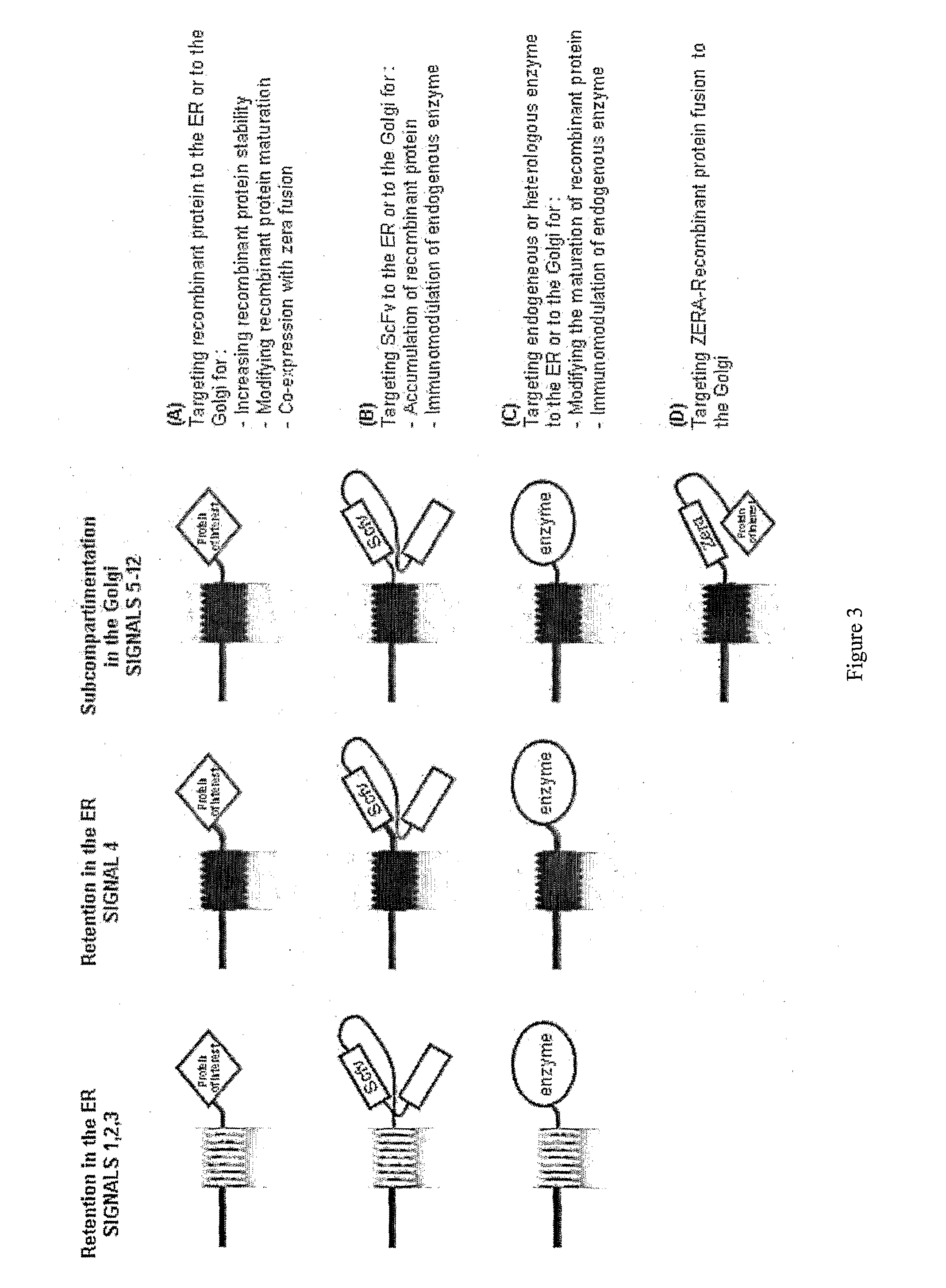Set of sequences for targeting expression and control of the post-translational modification of a recombinant polypeptide
a polypeptide and post-translational modification technology, applied in the field of recombinant proteins production, can solve the problems of complex therapeutic proteins produced in prokaryotes that are not always properly folded or processed to provide the desired degree of biological activity, and many post-translational modifications (ptms),
- Summary
- Abstract
- Description
- Claims
- Application Information
AI Technical Summary
Benefits of technology
Problems solved by technology
Method used
Image
Examples
example a
Addressing Proteins to the ER and / or GA (Annexed FIG. 3A)
Example 1
Identification of the Targeting Signal
1. Localisation of the Early Golgi Type H Membrane Proteins
[0223]To better understand the mechanisms allowing the selective retention of N-glycan processing enzymes in the early Golgi compartments, the localization of a series of GFP fusions to four different members of the N-glycan processing machinery (α-glucosidase I, mannosidase I, N-acetylglucosaminyltransferase I and b-1,2-xylosyltransferase, annexed FIG. 4) was studied after stable expression in tobacco BY-2 cells.
[0224]The construct for expressing the GFP fusion protein was made as disclosed in Saint-Jore-Dupas et al, 2006 (ref. 58). All Mannosidase I fusion constructs were derived from the full-length GFP fusion (here called ManI-GFP) originally described by Nebenführ et al. (1999) (ref. 43).
[0225]First, a linker containing an AatII restriction site was introduced between the ManI and the GFP coding regions. In combinatio...
example 2
Description of Identify Sequences
[0320]As shown in the previous examples, each signal listed in Table 3, is sufficient to target a reporter protein such as the green fluorescent protein to the ER and / or the GA (see annexed FIGS. 25A and 25B).
TABLE 3LOC = Localisation of reporter protein when fused to the signal (cf annexed FIG. 1)SEQSignalSequenceLOC.ID noSignal 1MTGASRRSARGRIER1First 13 amino acids of Arabidopsisthaliana glucosidase ISignal 2MARGERRRRAER2First 10 amino acids of Homo sapiensglucosidase I Signal 3MNDRRPQRKRPAER3Last 11 amino acids at the C-terminal end of At calnexinSignal 4MTGASRRSAR GRIKSSSLSP GSDEGSAYPP SIRRGKGKELER8First 150 amino acids of AthVSIGAFKTNL KILVGLIILG IIVIYFVINR LVRHGLLFDEglucosidase ISQKPRVITPF PAPKVMDLSM FQGEHKESLY WGTYRPHVYFGVRARTPLSL VAGLMWLGVK DEMYVMRHFCSignal 5MARGSRSVGS SSSKWRYCNP SYYLKRPKRL ALLFIVFVCVER + GA32First 49 amino acids of Glycine maxSFVFWDRQTmannosidase ISignal 6MARGSRSVGS SSSKWRYCNP SYYLKRPKRL ALLFIVFVCVER + GA33First 99 amino aci...
example 3
Prevention of the Addition of Immunogenic Residue on N-Glycans by Storage of Recombinant Protein within the Early Secretory Pathway Compartment by Using Targeting Sequence
[0335]The structural analysis of plant ER-resident proteins has shown that they bear exclusively high-mannose-type N-glycans (Navazio et al., 1997 (ref. 41), 1998 (ref. 42); Pagny et al., 2000 (ref. 49)). These oligosaccharide structures are common to plants and mammals, and therefore are not immunogenic. This observation has suggested a strategy to prevent the association of immunogenic residues such beta1,2 xylose or alpha1,3 fucose to plant-made pharmaceuticals (PMPs) N-glycans. This strategy consists in the storage of recombinant proteins within the ER, i.e., upstream of Golgi cisternae, where immunogenic glyco-epitopes are added to maturing plant N-glycans. It was first shown that the addition of H / KDEL amino acid sequences at the C-terminal end of a recombinant soluble protein is sufficient for its retention ...
PUM
| Property | Measurement | Unit |
|---|---|---|
| Length | aaaaa | aaaaa |
| Acidity | aaaaa | aaaaa |
| Nucleic acid sequence | aaaaa | aaaaa |
Abstract
Description
Claims
Application Information
 Login to View More
Login to View More - R&D
- Intellectual Property
- Life Sciences
- Materials
- Tech Scout
- Unparalleled Data Quality
- Higher Quality Content
- 60% Fewer Hallucinations
Browse by: Latest US Patents, China's latest patents, Technical Efficacy Thesaurus, Application Domain, Technology Topic, Popular Technical Reports.
© 2025 PatSnap. All rights reserved.Legal|Privacy policy|Modern Slavery Act Transparency Statement|Sitemap|About US| Contact US: help@patsnap.com



